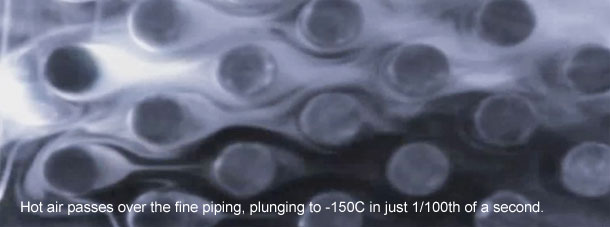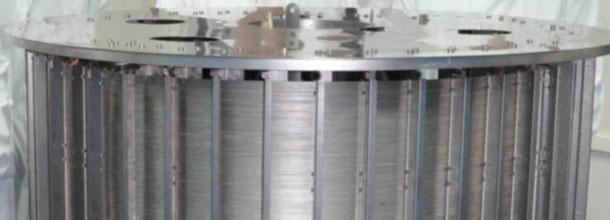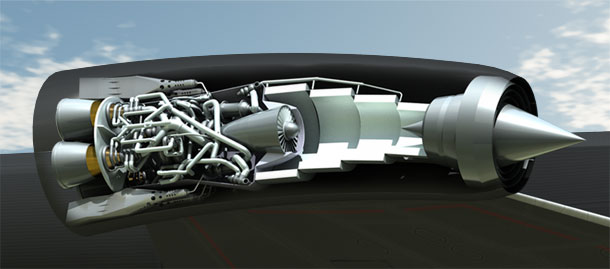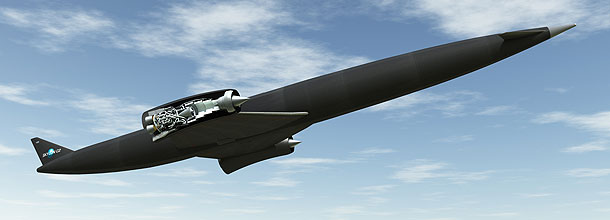Is this the biggest breakthrough in propulsion since the jet engine?
November 30, 2012

Hot air passes over the fine piping, plunging to -150C in just 1/100th of a second (credit: Mark Ford et al./Reaction Engines Ltd.)
Reaction Engines Ltd. has announced what is says is the “biggest breakthrough in aerospace propulsion technology since the invention of the jet engine.”
Critical tests have been successfully completed on the key technology for SABRE, an engine that will enable aircraft to reach the opposite side of the world in under four hours, or to fly directly into orbit and return in a single stage, taking off and landing on a runway.

Ultra-lightweight heat exchangers are the key enabling components in SABRE engines for Mach 5 cruise and aircraft-like access to space (credit: Reaction Engines)
SABRE, an air-breathing rocket engine, uses a combination of jet turbine and rocket technology. Its innovative pre-cooler technology is designed to cool the incoming airstream from over 1,000⁰C to minus 150⁰C in less than 1/100th of a second without blocking with frost.
The recent tests have proven the cooling technology to be frost-free at the crucial low temperature of -150⁰C.
The European Space Agency (ESA) has evaluated the SABRE engine’s pre-cooler heat exchanger on behalf of the UK Space Agency, and has given official validation to the test results:
“The pre-cooler test objectives have all been successfully met and ESA are satisfied that the tests demonstrate the technology required for the SABRE engine development.”

This advanced combined cycle air-breathing SABRE rocket engine enables aircraft to operate easily at speeds of up to five times the speed of sound or fly directly into Earth orbit (credit: Reaction Engines)
The U.K. Minister for Universities and Science, David Willetts said: “This is a remarkable achievement for a remarkable company.
Building on years of unique engineering know-how, Reaction Engines has shown the world that Britain remains at the forefront of technological innovation and can get ahead in the global race. This technology could revolutionize the future of air and space travel.”
Well over 100 test runs, undertaken at Reaction Engines Ltd’s facility in Oxfordshire, integrated the ground-breaking flight-weight cooling technology and frost control system with a jet engine and a novel helium cooling loop, demonstrating the new technologies in the SABRE engine that drive its highly innovative and efficient thermodynamic cycle.
This success adds to a series of other SABRE technology demonstrations undertaken by the company including contra-rotating turbines, combustion chambers, rocket nozzles, and air intakes and marks a major advance towards the creation of vehicles like SKYLON — a new type of reusable space vehicle that will be powered by SABRE engines, designed primarily to transport satellites and cargo into space.

SKYLON is an unpiloted, reusable spaceplane intended to provide reliable, responsive and cost effective access to space. Currently in early development phase, the vehicle will be capable of transporting 15 tonnes of cargo into space. It is the use of SABRE’s combined air-breathing and rocket cycles that enables a vehicle that can take off from a runway, fly direct to earth orbit and return for a runway landing, just like an aircraft. (Credit: Reaction Engines)
“These successful tests represent a fundamental breakthrough in propulsion technology. Reaction Engines’ lightweight heat exchangers are going to force a radical re-think of the design of the underlying thermodynamic cycles of aerospace engines.
These new cycles will open up completely different operational characteristics such as high Mach cruise and low cost, re-usable space access, as the European Space Agency’s validation of Reaction Engines’ SABRE engine has confirmed.
“The SABRE engine has the potential to revolutionize our lives in the 21st century in the way the jet engine did in the 20th Century. This is the proudest moment of my life.”